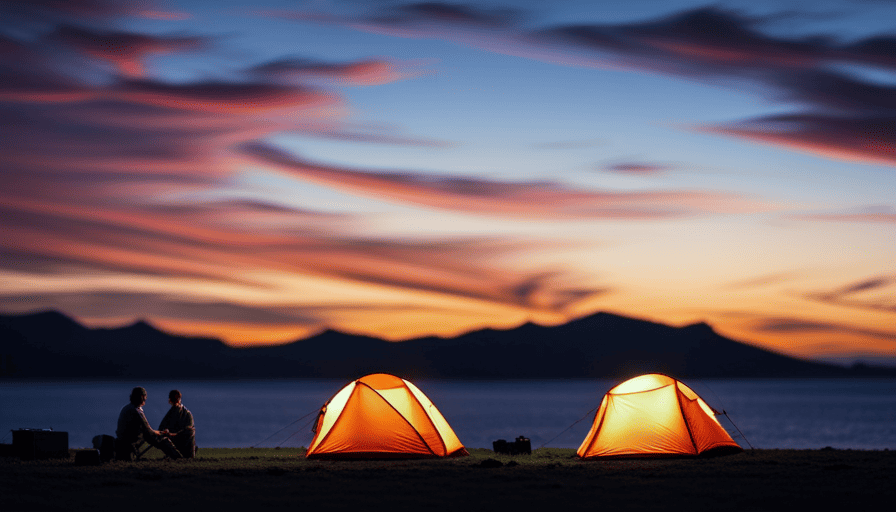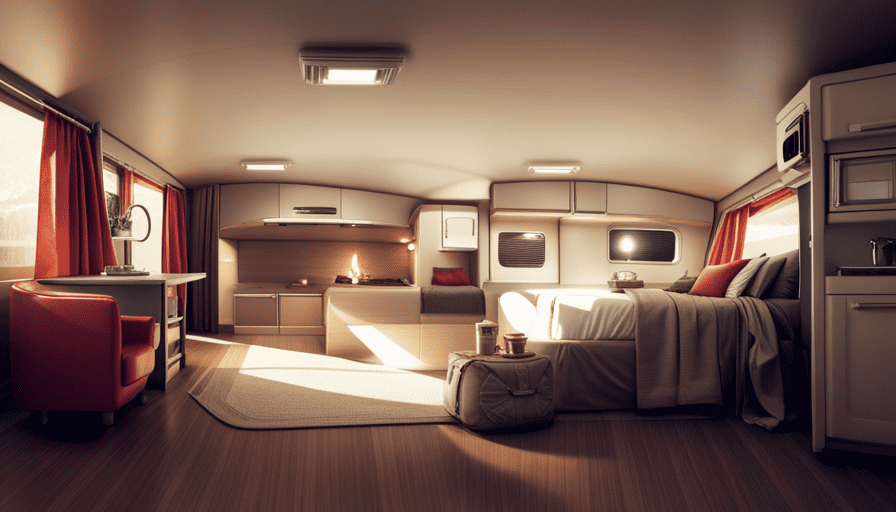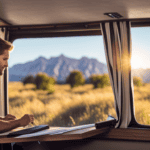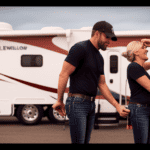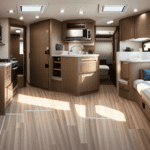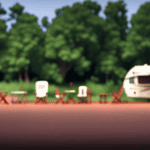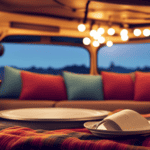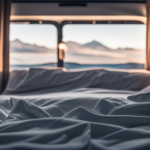Envision the excitement of embarking on a journey, discovering uncharted territories, and making memories that will last a lifetime. Now, imagine doing all this from the ease and comfort of your personal camper, a cozy retreat from the everyday.
Setting up a camper may seem like a daunting task, but fear not! We’ve got you covered. In this article, we will guide you through the steps necessary to set up your camper and transform it into your personal oasis.
From choosing the perfect campsite to organizing the interior space, we’ll provide you with all the information you need to make your camper adventure a success.
So grab your checklist and let’s get started on this exciting journey together. Get ready to experience the freedom and joy of camper living as we show you how to set up your camper like a pro!
Key Takeaways
- Choosing the right campsite is crucial for a successful camping trip
- Properly leveling the camper is essential for stability and comfort
- Connect utilities (water, electricity) securely to the camper
- Maximize storage and create a cozy living space inside the camper
Choose the Right Campsite
You’ll want to make sure you choose the right campsite, so you can create lasting memories and immerse yourself in the beauty of nature. Finding the perfect campsite is crucial to a successful camping trip.
Start by considering the location. Do you prefer the tranquility of a secluded campsite or the convenience of one near amenities? Research the area and read reviews to ensure it meets your needs and preferences.
Once you’ve found the ideal spot, it’s time to pack essential camping gear. Make sure you have a sturdy tent, sleeping bags, cooking equipment, and a cooler for food storage. Don’t forget to bring insect repellent, sunscreen, and a first aid kit. Setting up a comfortable and functional campsite will enhance your camping experience.
As you prepare to level your camper, make sure to choose a flat area to park it. Use leveling blocks or ramps to ensure stability and prevent any discomfort during your stay.
With the perfect campsite secured and your camper leveled, you’re ready to embark on a memorable camping adventure.
Level Your Camper
Once you’ve found a suitable spot, it’s important to ensure that your camper is level to maximize comfort and stability. Leveling your camper is essential for a good night’s sleep and to prevent any unnecessary strain on the structure. Here are some leveling techniques and equipment needed to get the job done right:
-
Use a bubble level: Place a bubble level on the floor of your camper to determine which areas need adjustment. This will help you identify the high and low points.
-
Chock the wheels: Once you’ve identified the high side, place wheel chocks on the low side to prevent your camper from rolling. This will provide stability and prevent any unwanted movement.
-
Adjust the leveling jacks: Most campers are equipped with leveling jacks. Extend or retract them accordingly to level your camper. Use a leveling block or ramp under the jacks for additional support.
Remember to take your time and make small adjustments to achieve the perfect level. Once your camper is level, you can move on to the next step of connecting utilities (water, electricity) to make your camping experience even more enjoyable.
Now that your camper is level, let’s move on to connecting utilities (water, electricity) for a hassle-free camping experience.
Connect Utilities (Water, Electricity)
To ensure a hassle-free camping experience, start by connecting the utilities of water and electricity to your camper.
First, locate the water hookup at your campsite and connect the water hose to it. Make sure to tighten the connection to avoid any leaks. Once the hose is securely attached, turn on the water supply and check for any leaks or drips. It’s essential to have a steady flow of water for cooking, cleaning, and showering.
Next, locate the electrical hookup and plug in the power cord. Ensure that the power source matches the requirements of your camper. Plug the cord into the designated outlet and secure it tightly. This step will provide you with electricity to power your appliances, charge your devices, and illuminate your camper at night.
With the water and electricity connected, you’re one step closer to enjoying your camping adventure.
Now, let’s move on to setting up your awning and outdoor furniture, making your campsite cozy and inviting.
Set Up Your Awning and Outdoor Furniture
Now that your water and electricity are connected, let’s get your awning and outdoor furniture ready to create a cozy and inviting campsite. Did you know that studies have shown that spending time outdoors can reduce stress levels by up to 50%? So, let’s make your outdoor space the perfect place to relax and unwind.
First, let’s talk about awning maintenance. Your awning provides shade and protection from the elements, so it’s essential to keep it in good condition. Regularly clean it with mild soap and water to remove dirt and debris. If you notice any tears or damage, patch them up promptly to prevent further deterioration.
Now, onto outdoor cooking tips. Setting up a camp kitchen can be fun and convenient. Invest in a portable grill or stove, and make sure to have all the necessary utensils, cookware, and ingredients. Don’t forget to set up a designated area for food prep and cleaning.
As you enjoy your outdoor space, take a moment to appreciate the natural surroundings. The sound of chirping birds and the scent of fresh air can truly rejuvenate the soul. So, as we move on to the next section about organizing the interior space, remember to bring a bit of the outdoors inside by incorporating natural elements and earthy tones.
Organize the Interior Space
Create a cozy and inviting atmosphere inside your camper by organizing the interior space to reflect your personal style and make it feel like a home away from home.
To maximize storage, consider utilizing vertical space by installing shelves or hooks on the walls. This will help keep your belongings organized and easily accessible. Additionally, invest in collapsible storage containers or bins that can fit under seats or in small spaces to make the most of every inch.
To create a cozy atmosphere, decorate with soft fabrics, such as throw pillows and blankets, in colors and patterns that reflect your personal style. Hang curtains or blinds to add privacy and a touch of homeliness. Finally, incorporate personal touches like photos or artwork to make the space feel uniquely yours.
By organizing the interior space to maximize storage and creating a cozy atmosphere, your camper will become a comfortable retreat.
Now, let’s move on to setting up your sleeping area.
Set Up Your Sleeping Area
Transform your sleeping area into a cozy haven with soft, plush bedding and cozy lighting. When setting up your camper, maximizing comfort should be a top priority. Start by investing in a high-quality mattress that provides the support you need for a good night’s sleep. Layer it with luxurious bedding, including soft sheets, fluffy pillows, and a warm comforter. This will not only make your sleeping area more inviting, but it’ll also ensure a restful night’s sleep.
In addition to comfort, storage solutions are essential in a camper. Make the most of the limited space by utilizing under-bed storage containers or collapsible bins. These can store extra blankets, pillows, or clothing, keeping your sleeping area clutter-free. Consider installing shelves or hanging organizers on the walls to hold books, electronics, or personal items.
To create a cozy atmosphere, incorporate warm lighting options. String lights or battery-operated candles can add a touch of ambiance, while a small bedside lamp can provide functional lighting for reading or getting ready for bed.
Once you’ve transformed your sleeping area into a comfortable retreat, it’s time to move on to hooking up appliances and electronics. By ensuring that everything is properly connected and functioning, you can enjoy all the conveniences of home while on the road.
Hook Up Appliances and Electronics
Maximize the convenience and comfort of your camper by hooking up your appliances and electronics. Here are some important tips to ensure appliance safety and efficient power management:
-
Appliance Safety
-
Make sure all appliances are in good working condition before connecting them to the camper’s electrical system.
-
Use surge protectors to prevent damage from power surges or fluctuations.
-
Keep appliances away from water sources to avoid electrocution hazards.
-
Regularly inspect cords and plugs for any signs of wear or damage.
-
Power Management
-
Determine the power requirements of each appliance to avoid overloading the camper’s electrical system.
-
Use energy-efficient appliances to conserve power and extend battery life.
-
Prioritize essential appliances and limit the use of high-power devices simultaneously.
-
Consider using solar panels or a generator for additional power sources.
By following these guidelines, you can ensure the safety of your appliances and effectively manage the power supply in your camper. Now that your appliances are set up, let’s move on to the next section and stock up on supplies.
Stock Up on Supplies
Get ready to fully enjoy your camping experience by stocking up on all the necessary supplies that’ll make your adventure even more memorable.
When it comes to essential camping gear, there are a few items you shouldn’t leave home without. First, make sure you have a sturdy tent that can withstand various weather conditions. A sleeping bag and comfy camping mat are also essential for a good night’s sleep. Don’t forget to pack a camping stove, cookware, and utensils for meal planning and cooking. With these items, you’ll be able to whip up delicious meals and enjoy the great outdoors.
Meal planning is crucial when camping, so be sure to plan your meals ahead of time. Consider easy-to-make dishes that require minimal ingredients and prep time. Don’t forget to pack non-perishable food items like canned goods, trail mix, and snacks to keep you fueled throughout your camping trip.
As you stock up on supplies, familiarize yourself with safety precautions. It’s important to know how to properly store food to avoid attracting wildlife. Additionally, be mindful of fire safety and always follow campground rules and regulations. By taking these safety measures, you can ensure a safe and enjoyable camping experience.
Now that you’ve stocked up on supplies, let’s move on to familiarizing yourself with safety precautions for a worry-free camping adventure.
Familiarize Yourself with Safety Precautions
Before heading out on your camping adventure, it’s important to familiarize yourself with safety precautions to ensure a safe and enjoyable experience.
One key safety measure is properly storing food to avoid attracting wildlife. Bears have an incredible sense of smell and can be drawn to campsites by the scent of food. To prevent bear encounters, make sure to store all food and scented items in bear-resistant containers or hang them from a tree at least 10 feet off the ground.
Additionally, it’s crucial to follow campground rules and regulations. These rules are in place to protect both campers and the environment. Be sure to familiarize yourself with the specific rules of the campground you’re staying at, such as fire restrictions and quiet hours.
Understanding emergency procedures is another vital aspect of camper safety. Take the time to review the emergency protocols provided by the campground or camper rental company. This includes knowing the location of fire extinguishers, first aid kits, and emergency exits. It’s also essential to ensure proper ventilation inside the camper. Carbon monoxide can build up quickly in enclosed spaces, so make sure to open windows or vents when using gas-powered appliances.
By taking these safety precautions, you can minimize risks and fully enjoy your camper adventure!
Enjoy Your Camper Adventure!
Make the most of your camper adventure by embracing the freedom and flexibility it offers. One of the key aspects of enjoying your camper adventure is ensuring proper camper maintenance. Before embarking on your trip, make sure to check the tires, brakes, and lights to ensure they’re in good working condition.
It’s also important to regularly clean and inspect the interior and exterior of your camper to prevent any issues from arising during your trip.
When it comes to cooking in a camper, there are a few tips to keep in mind. First, make sure to stock up on essential cooking utensils and supplies that’re compact and easy to store. This’ll help you maximize the limited space in your camper’s kitchen area. Additionally, consider meal planning and prepping before your trip to minimize the time spent on meal preparation and cleanup.
Another useful tip is to utilize the outdoor cooking options that many campers offer, such as a grill or a portable stove. This allows you to enjoy the fresh air and scenery while preparing your meals. Lastly, don’t forget to pack some non-perishable food items as backup, in case you encounter any unexpected challenges while on the road.
By following these tips for camper maintenance and cooking, you can ensure a smooth and enjoyable camper adventure. So go ahead, embrace the freedom of the open road, and savor the unique experience that camping in a camper offers.
Frequently Asked Questions
What are the essential supplies needed for a camper setup?
When setting up a campsite, there are some essential camping gear and tips that we can’t do without.
First and foremost, make sure you have a reliable tent, sleeping bags, and camping chairs. Don’t forget to pack a sturdy cooler to keep your food fresh and drinks cold.
Setting up a campfire is crucial, so bring along firewood, matches, and a fire starter. Other essentials include a camping stove, cooking utensils, and lighting options like lanterns or headlamps.
Remember to also bring insect repellent, first aid kit, and a camping table for convenience.
How can I ensure the safety of my camper while setting it up?
When it comes to camper security, preventing theft is crucial. There are several measures we can take to ensure the safety of our camper.
Firstly, investing in a quality lock system for the doors and windows is essential. Additionally, installing an alarm system and motion sensor lights can act as deterrents.
It’s also important to park in well-lit, secure areas and consider using a hitch lock to prevent theft of the entire camper.
Are there any specific tips for leveling a camper on uneven terrain?
When it comes to leveling a camper on uneven terrain, there are a few important tips to keep in mind.
One interesting statistic to consider is that 72% of camper owners have encountered issues with stability on uneven surfaces. To avoid common mistakes, use leveling blocks or ramps to raise the low side of the camper.
It’s also crucial to check for any potential hazards like rocks or tree roots before parking. Properly stabilizing your camper will ensure a safe and enjoyable camping experience.
How do I properly connect and disconnect utilities such as water and electricity?
To properly connect and disconnect utilities such as water and electricity in a camper, there are a few key steps to follow.
First, ensure that your camper is parked on a level surface for stability.
Then, use the appropriate hoses and connectors to connect to the campground’s water and electrical hookups. Make sure to check for any leaks and secure the connections tightly.
To conserve water and electricity while camping, practice mindful usage, turn off appliances when not in use, and consider using solar panels or a generator for power.
Additionally, properly store and maintain camper tires by checking the tire pressure regularly, rotating them as needed, and keeping them clean and protected from the elements.
Are there any recommended storage solutions for organizing the interior space of a camper?
When it comes to RV storage ideas and space-saving solutions for campers, we’ve got you covered! Let’s talk about how to organize the interior space of your camper like a pro.
From collapsible storage bins that magically multiply your storage space to hanging organizers that can hold everything from shoes to toiletries, there are endless options to maximize your space.
Don’t forget about utilizing under-bed storage and installing hooks for hanging items. With these clever storage solutions, you’ll have a tidy and organized camper in no time!
Is It Necessary to Gut a Camper Before Setting It Up?
When setting up a camper, is gutting a camper made easy? Depending on your preferences and needs, gutting a camper before setting it up may or may not be necessary. Some campers prefer to start with a blank canvas, allowing them to customize the interior layout, while others find it convenient to work with the existing structure. Ultimately, the decision to gut a camper depends on your specific requirements and vision for your camping experience.
Conclusion
So there you have it, folks! Setting up a camper can be a breeze if you follow these simple steps.
Remember to choose the perfect campsite, level your camper, and connect all the necessary utilities. Don’t forget to set up your awning and outdoor furniture for a cozy outdoor space.
Inside, organize everything efficiently and hook up your appliances and electronics. Stock up on supplies and familiarize yourself with safety precautions.
And now, it’s time to hit the road and enjoy the wild adventures that await us, like a breath of fresh air on a sunny day. Happy camping!

